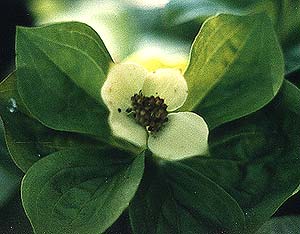 Bunchberry:
Bunchberry:
The Smallest Dogwood
This dogwood (Cornus canadensis) only grows to around eight inches tall. If you get down on your belly, a patch of it looks like the tiniest imaginable dogwood forest. The leaves are the same, the flowers are the same, everything about it is like a big dogwood, only teency.
The common name Bunchberry is most used, but the second most often heard name for them is Crackerberry, which was probably the most in use in the Victorian era. A couple sources say this name arose from the sound it makes if you step on it on a woodland walk. I found this explanation very doubtful. Even though they have an "exploding pollen" mechanism, it's by no means loud enough for the human ear.
So I asked in a gardening group if they knew where this name came from & I was led to Timothy Coffey's The History and Folklore of North America Wildflowers (1994) which informed me, "The word Crackerberry comes from 'crake' or crow; so crackerberry means crowberry."
Suddenly the name made perfect sense, as it is also called pigeonberry & squirrelberry because wildlife is fond of it, & like manzanitas & cotoneasters, occasionaly called bearberry because bears will remember when it fruits & return to colonies of bunchberries late summer or autumn.
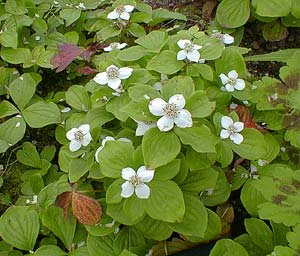 Due to its its size or behavior it has also been known as dwarf dogwood, dwarf cornel, low cornel, ground dogwood, bunchplum, or creeping dogwood, besides cuckoo-plum, frothberry, or dogberry. In New England, where there arose a tradition of adding a few bunchberries to plum pudding for the sake of the added color or because the amount of pectin in bunchberries causes pudding to set up without need of cornstarch, it became known as puddingberry. French Canadians call it among other names quatre-temps after the leaves arranged in fours.
Due to its its size or behavior it has also been known as dwarf dogwood, dwarf cornel, low cornel, ground dogwood, bunchplum, or creeping dogwood, besides cuckoo-plum, frothberry, or dogberry. In New England, where there arose a tradition of adding a few bunchberries to plum pudding for the sake of the added color or because the amount of pectin in bunchberries causes pudding to set up without need of cornstarch, it became known as puddingberry. French Canadians call it among other names quatre-temps after the leaves arranged in fours. Native Americans had many names for it including in Cree pihew-mina the grouseberry & kawiskowimin the itchy-chin-berry. This last name is a bit of a mystery to me. One explanation is that the pollen causes an allergic reaction if anyone crawls through the flowers or puts their ear to the ground near it. Once again, here was an explanation sounds farfetched to me. But some Indian peoples used all sorts of dogwoods, including bunchberry, to bandage wounds, so their may have been a belief that dogwoods generally or bunchberry in particular relieved itch. I have found only thin evidence for this explanation, but the Abneki Indians believed in bunchberry's curative powers, & called it batkilawinbizon which means roughly "plant that fixes pain in side," reflecting a persisting alternative-medicines claim that bunchberry can control bedwetting or assist in kidney disease.
There are also modern herbalists who claim dogwoods can relieve symptoms of gum disease if bark is chewed or if dogwood twigs are used for cleaning between teeth. All of these alleged values are debatable, but a mild astringent quality is sufficient to justify such folk beliefs.
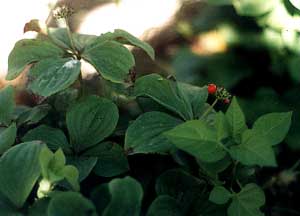 A shade-loving Northwest native woodland groundcover, it can be a bit fragile in gardens if its needs are imperfectly met, but spreads by underground runners & by seeds thriving marvelously if it finds itself in the right situation.
A shade-loving Northwest native woodland groundcover, it can be a bit fragile in gardens if its needs are imperfectly met, but spreads by underground runners & by seeds thriving marvelously if it finds itself in the right situation.The seeds can take two or three years to germinate fully, by which time the parent plants will already be spreading from the rhizomes. It needs acidic, well-drained moist soil, & a fair amount of shade with a little morning or afternoon sunlight, & sun should never be so much as to raise the soil temperature above 65 degrees as bunchberry is extremely heat sensitive.
It tends to look its absolute best throughout the spring. Summer heat is its biggest foe in the garden. If it can be planted under a large deciduous tree that fully shades it for the hot season, it'll have a much better chance of retaining its looks in summer. I suggest deciduous because that has worked for us, & so that it it will have more sunlight in seasons other than summer, for though it needs shade to thrive, if it gets way too little sunlight year-round, it will not set many flowers, & will produce few if any berries. In nature however, bunchberry prefers shade of conifer forests, because falling needles keep the acidity level in the range preferred by bunchberry, & except for help from a gardener, deciduous leaf-fall could easily bury such a small plant.
If its needs are imperfectly met it may linger as a feeble purple-brown plant that does not spread nor raise its leaves higher than three or four inches (this is essentially its winter appearance). Being near rotting deadfall helps bunchberry a great deal, as it is frequently found growing naturally around rotting stumps & logs.
To meet its desire for rotting wood in its vicinity, I started it in soil into which I had buried many whole twigs before planting the bunchberries, & I worked deeply into the soil a considerable amount of wood shavings in which our pet rats had pooped, besides organic matter from finished compost. After it is established it is a good idea to mulch every two or three years with pine or fir needles gathered from the woodlands.
The wood particles worked into the soil seem really to do the trick & we've experienced none of the troubles some people have when attempting to establish a healthy patch of buchberry. After a couple years, shavings or woodchips will have broken down into good organic compost, so to keep the quotient of decaying wood quotient current, every couple years I pound a few sticks (mostly sundry bush trimmings) flush into the soil, as I also do for Huckleberries & other such plants that have a strong symbiotic relationship with the sorts of beneficial fungus that break down wood.
We have two colonies of this midget shrub, one group in the deep shade of a large fountaining Franchet's Cotoneaster amidst trilliums & ferns. This small patch does not bloom well, though the plants have survived for several years. The larger, nicely spreading patch is in the dappled shade of our enormous old Chokecherry. It is this latter colony photographed for this page.
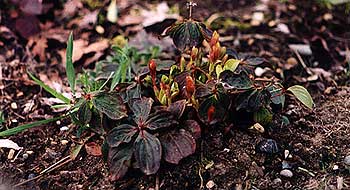 Athough bunchberry ought to be deciduous like all dogwoods, it has surprised me by not dropping all its leaves in autumn. It always still has some of its leaves by the following spring, so in our garden at least, it is semi-deciduous to semi-evergreen.
Athough bunchberry ought to be deciduous like all dogwoods, it has surprised me by not dropping all its leaves in autumn. It always still has some of its leaves by the following spring, so in our garden at least, it is semi-deciduous to semi-evergreen.I've included one early April photo (the fourth picture) so you can see how much of last year's growth remains still with autumn purple colors. A scant week after the early April photo was taken, the new growth you can see budding had become lush & bright green. New leafage completely obscures whatever remains of last year's leaves.
The fact that it does keep some purplish leaves through the winter means there is never a season when it is completely without character for the garden. Obviously in colder areas, where it can also thrive, it would not have this partially evergreen capacity, but on mild Puget Sound it simply never dies back entirely.
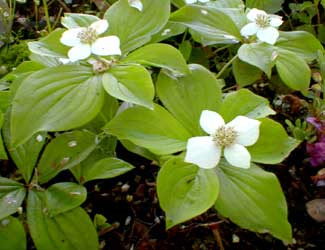 Bunchberry flowers in May & June, though a few flowers will appear earlier, at the tail-end of April, & in Autumn it will have a moderate rebloom.
Bunchberry flowers in May & June, though a few flowers will appear earlier, at the tail-end of April, & in Autumn it will have a moderate rebloom.At first appearance the flowers are mauve, almost the same color as the newly emerged leaves, but it only takes a day or two before the green flowers turn white, & toward the end of the main blooming cycle they acquire a faint purple blush.
Spring's flowers become red fruits, but frequently the autumn rebloom fails to be pollinated. These season's-end blooms last & last & last, sometimes through the entirety of winter, hoping against hope to attract pollinators. These lasting autumn blooms turn to a rich crimson in winter.
In actuality the single bloom is made up of many tiny blooms surrounded by four white brachts, which is how an apparently single blossom can eventually becomes a small "bunch" of berries instead of one big berry.
The miniscule true flowers are pollinated by flying insects which are attracted by the white brachts. When the insect alights, the touch of the pollinator induces each of the true flower to "explode" or catapult pollen at the visiting fly, moth, or bee. It is not the most effective method of pollination, & bunchberries have never been grown primarily for their fruit because the shrublet simply will not produce a lot of fruit. The July photo on this page shows a specimen with just one red berry present, which is often the situation.
As it reblooms through the year, the fruit can appear at any time from late spring, throughout summer, or early autumn, but in our garden, they are most numerous in June (though never extremely numerous). The carpeting shrublet develops displays clusters of pea-sized scarlet berries with yellow pulp, with either one or two large seeds per berry.
he berries are edible, not the least bit tart & only a little sweet, so rather bland. Northwest aboriginal peoples traditionally preserved them in bearfat, as they did with many berries, such as manzanitas which are far less tasty than bunchberries. Though too difficult to grow for commercial purposes, bunchberry is nevertheless one of the best berries for homemade jellies & good for thickening up sweeter berries that would otherwise need pectin added.
To see how lovely it is at the height of autumn, see the
Bunchberry Autumn Leaves Page
& to see the attractive berries at their best, see the
Bunchberry Page of the Drupes & Berries Gallery
Bunchberry Autumn Leaves Page
& to see the attractive berries at their best, see the
Bunchberry Page of the Drupes & Berries Gallery